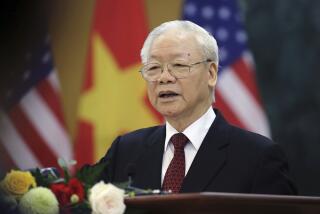War Is History for Vibrant Vietnam
HO CHI MINH CITY, Vietnam — In the final days of the Vietnam War 30 years ago, a U.S.-trained South Vietnamese pilot named Nguyen Thanh Trung defected to the North mid-mission. Faking engine problems, he peeled off from his squadron and headed back to Saigon to bomb the presidential palace and the international airport.
Today, Trung flies a U.S.-made Boeing 777 for Vietnam Airlines and shuttles passengers from abroad to the airport he once bombed. His son is studying aviation in Australia.
“My generation was raised to fight the war,” Trung said, “but today’s generation is here to capitalize on the peace.”
To them, Saigon’s fall to communist forces on April 30, 1975, is ancient history. Some Americans may still grapple with its legacy, but the Vietnamese have moved on, seldom speaking of what they call the American War. For them, there is only one focus now: national development.
Half the nearly 83 million people in Vietnam were born after Saigon fell and was renamed Ho Chi Minh City, after the North’s iconic leader. The other half has forgiven, if not forgotten, following Vietnam’s long tradition of repairing relations with former foes and extracting lessons from the past. After defeating China in 1426, Vietnam provided it with boats and horses to carry its vanquished army home.
So what have the decades since brought to a country that Air Force Gen. Curtis LeMay once suggested the United States should bomb “back to the Stone Age”? Ironically, if you took away the still-ruling Communist Party and discounted the perilous decade after the war, the Vietnam of today is not much different from the country U.S. policymakers wanted to create in the 1960s.
It is a peaceful, stable presence in the Pacific Basin, with an army that has been whittled down to 484,000 troops. Its economy, a mix of Karl Marx and Adam Smith, has the highest growth rate in Southeast Asia. Private enterprise is flourishing, a middle class is growing, poverty rates are falling. The United States is a major trading partner, and Americans are welcomed with a warmth that belies the two countries’ history.
Urban youth have opportunities undreamed of in their parents’ time. Many are studying English -- their grandparents learned French and their parents Russian or German -- and flocking to colleges, generally indifferent to the Communist Party unless they want a government job.
Among the 54 universities in Ho Chi Minh City is Vietnam’s first foreign-run educational facility, the Royal Melbourne Institute of Technology. Its 1,400 students come from 20 countries, including the United States, and earn degrees in software engineering, commerce and marketing on a modern campus.
When the institute’s president, Michael Mann, visited Vietnam in 1984 as a young diplomat from Australia, the country was so poor and famished that he brought rice to ensure he would have something to eat.
“I looked around then and said: ‘There’s no way these people can catch up. They’re too far behind,’ ” said Mann, a former ambassador to Vietnam. “Today I believe they can. Vietnam deserves good marks for its development efforts in the last decade, and the students are very sharp, very eager to learn. They have the freedom to do just about anything they want except promote political change, and they don’t appear interested in that.”
The party that has given its people economic and social freedom has not yielded on political freedom. Ultimate authority still rests with the Communist Party’s Politburo in Hanoi. Its 15 members are not accountable to anyone but themselves, and criticizing their decisions would be considered a serious crime. No one expects significant political reform to come soon.
In fact, ask a member of the postwar generation if he or she wants more democracy, with a multiparty system and media without state controls, and the response usually echoes that of Royal Melbourne student Pham Nguyen Hai, 20: “I feel we have enough freedom. We know what we can do.”
Like Hai, young Vietnamese seem in no more of a hurry to reform the political structure than the Communist Party is to relinquish power -- as long as the leadership continues to deliver stability, opportunity and higher living standards.
“Looking back on our early revolutionary history, it was Communists who led the successful campaign to reunite the country,” said Hoan Dung, 78, a retired North Vietnamese general. “I don’t see the reason for multiple parties. I don’t think Vietnam needs an opposition, because the Communist Party has done it right.”
The same could not have been said in the decade that followed the war.
In its revolutionary zeal, the party collectivized farms. Without incentives, productivity went down and Vietnam became a rice importer. The party confiscated property and wealth. Overnight, millionaires became paupers. Children of South Vietnamese soldiers were denied access to the best colleges and the good jobs, and the spirit of reconciliation withered.
Newspapers disappeared, movie theaters closed, bank safe-deposit boxes were sealed. Ordinary Vietnamese were forbidden to have contact with foreigners. More than 400,000 South Vietnamese were sent off to reeducation camps, some to languish for years.
One of those was Maj. Gen. Nguyen Hu Co, who remembers raising vegetables, cutting firewood and enduring interminable political lectures for 12 years.
Co, a Catholic who now lives in Ho Chi Minh City, says he attends church regularly and that neither he nor his family suffers any discrimination. His wife runs a small embroidery business, and four of his 12 children live in the United States, which he was planning to visit.
“I was in the camp with 45 other generals, and the cadre asked us again and again to understand a communist regime compared with a capitalist regime,” Co, 81, recalled recently at a party-sponsored news conference here. “Frankly, I couldn’t agree that communism was better than capitalism. But I could not say that. So I just listened and kept quiet.”
The so-called Dark Years of the postwar period ended in 1986. That’s when Hanoi’s aging leadership, facing famine, international isolation and national disillusionment, followed China’s lead and adopted, without great enthusiasm, a policy known as doi mo, or “renovation,” to move toward a more open economy. Some experts believe that nothing less than the survival of the Communist Party -- perhaps of Vietnam itself -- was at stake.
The results were dazzling. “It was as though the people knew just what to do without missing a step,” said Virginia Foote, president of the Washington-based U.S.-Vietnam Trade Council.
Thousands of shops and small businesses sprung up. Within a decade, Vietnam had become the world’s second-largest rice exporter, cut inflation from 700% a year to single digits, made plans for a stock exchange in Ho Chi Minh City and attracted investors from the United States, Australia and Taiwan.
Henry Nguyen, 31, whose family fled South Vietnam in 1975 along with hundreds of thousands of others, is among the newcomers with a stake in Vietnam’s future.
Nguyen grew up in Virginia -- “American through and through -- Big Macs, MTV, the NFL, that was me.” But his parents never let him forget his roots. They had a traditional altar at home for worshiping ancestors and spoke Vietnamese to Nguyen (who would usually answer in English). “Friends would come over and I was kind of embarrassed, wondering why my parents were so weird,” he said.
Nguyen’s father returned to Vietnam several years ago to start a telecommunications company, and Nguyen, who has degrees in Greek and Latin from Harvard and a medical degree from Northwestern, followed in 2002. Today, from his 11th-floor office overlooking the Saigon River, he runs a venture capital fund with $150 million to invest in Vietnam.
“If you exclude China,” he said, “I think Vietnam is one of the three top emerging markets in the world.”
Among its strengths, he listed political stability, a 94% literacy rate, a young, industrious population and a reliable, efficient workforce. “If you’re the World Bank or [a nongovernmental organization], this is a place you can really see results.”
Next year, Vietnam is likely to be granted membership in the World Trade Organization. But challenges lie ahead.
The bureaucracy is thick and the pace of economic reform frustratingly slow for foreign businesses. Vietnam’s human rights record has improved but still falls short of international standards. Education is poor in rural areas, where 80% of the population lives, and the government needs to create 1 million jobs each year just to keep up with young Vietnamese entering the workforce. Corruption is as pervasive as it was in the now-vanished South Vietnam.
The South’s final collapse began April 21, 1975, when a tearful Nguyen Van Thieu, South Vietnam’s president and commander in chief, told his nation and million-man army that he was stepping down. “I am resigning, but I am not deserting,” he said.
Then he flew to Taiwan with a fortune in gold.
Saigon fell nine days later without the feared bloodbath -- in fact, with hardly more than a stray shot fired. The United States’ longest war had claimed the lives of 3 million Vietnamese and 58,000 Americans.
Long forgotten by then were words that Ho Chi Minh had used to address the American people in the mid-1960s: “We will spread a red carpet for you to leave Vietnam. And when the war is over, you are welcome to come back because you have technology and we will need your help.”
In Saigon’s last desperate hours, U.S. pilots shuttling American and Vietnamese evacuees to 7th Fleet vessels 50 miles offshore had noted with alarm that the red warning light on their control panels flashed repeatedly, indicating that North Vietnamese missiles had “locked” onto their helicopters. But no SAMs were fired, and no choppers were lost.
The Americans had left Vietnam on Ho’s red carpet.
Lamb covered the Vietnam War for United Press International and the fall of Saigon for The Times. He was The Times’ Hanoi Bureau chief from 1997 to 2001.
*
(BEGIN TEXT OF INFOBOX)
Vietnam on the rise
Thirty years after the fall of Saigon, Vietnam is focused on economic development. Here’s a look at how the country of nearly 83 million people is faring:
GDP growth rate, 2003
China: 9.1%
India: 8.3%
Russia: 7.3%
Vietnam: 7.2%
Thailand: 6.7%
Laos: 5.5%
Sri Lanka: 5.5%
Malaysia: 5.2%
Mongolia: 5%
Philippines: 4.5%
Indonesia: 4.1%
World: 3.8%
Mexico: 1.3%
Brazil: -0.2%
--
GDP per capita
Malaysia: $8,922
Mexico: $8,707
Russia: $7,926
Brazil: $7,516
Thailand: $6,788
China: $4,475
Philippines: $4,021
Sri Lanka: $3,447
Indonesia: $3,138
India: $2,571
Vietnam: $2,240
Laos: $1,678
Mongolia: $1,651
--
Exports
These countries buy the largest proportions of Vietnamese exports. Crude oil, marine products, rice, coffee, rubber, tea and garments are among the biggest categories.
U.S.: 21.9%
Japan: 13.8%
Australia: 6.8%
China: 6.5%
Germany: 5.8%
Singapore: 4.6%
Britain: 4.4%
--
Declining poverty
1993: 58.1%
1998: 37.4%
2002: 28.9%
--
Living on less than a $1 a day
1990: 50.8%
1993: 39.9%
1996: 23.6%
1999: 16.9%
2002: 13.6%
2004: 10.6%
--
Sources: CIA World Factbook, United Nations, U.S.-Vietnam Trade Council, World Bank, U.S. Department of Commerce, U.S. Treasury, U.S. International Trade Commission.
Graphics reporting by Brady MacDonald
More to Read
Sign up for Essential California
The most important California stories and recommendations in your inbox every morning.
You may occasionally receive promotional content from the Los Angeles Times.










